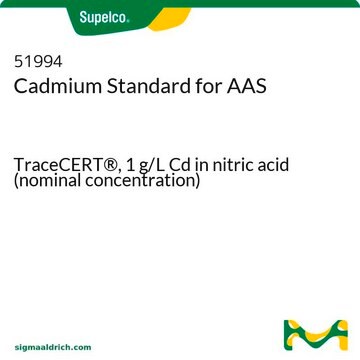270393
Tetrachloroethylene
suitable for HPLC, ≥99.9%
Sinonimo/i:
PCE, Perchloroethylene
About This Item
Prodotti consigliati
Densità del vapore
5.83 (vs air)
Tensione di vapore
13 mmHg ( 20 °C)
19 mmHg ( 25 °C)
Saggio
≥99.9%
Forma fisica
liquid
Purificato mediante
glass distillation
tecniche
HPLC: suitable
Impurezze
<0.050% water
Residuo dopo evaporazione
<0.0005%
Colore
APHA: ≤10
Indice di rifrazione
n20/D 1.505 (lit.)
P. eboll.
121 °C (lit.)
Punto di fusione
−22 °C (lit.)
Densità
1.623 g/mL at 25 °C (lit.)
λ
H2O reference
Assorbanza UV
λ: 290 nm Amax: 1.00
λ: 295 nm Amax: 0.30
λ: 300 nm Amax: ≤0.20
λ: 305 nm Amax: 0.10
λ: 350 nm Amax: 0.05
λ: 400 nm Amax: 0.03
applicazioni
food and beverages
Stringa SMILE
Cl\C(Cl)=C(\Cl)Cl
InChI
1S/C2Cl4/c3-1(4)2(5)6
CYTYCFOTNPOANT-UHFFFAOYSA-N
Cerchi prodotti simili? Visita Guida al confronto tra prodotti
Categorie correlate
Applicazioni
- Dispersive liquid-liquid microextraction as a novel enrichment approach for compound-specific carbon isotope analysis of chlorinated phenols.: This study introduces a novel microextraction technique involving tetrachloroethylene, enhancing the sensitivity and specificity of carbon isotope analysis in complex environmental samples (Martin et al., 2024).
- Photo-on-Demand In Situ One-Pot Synthesis of Carbonate Esters from Tetrachloroethylene.: This research presents a novel photochemical method for synthesizing carbonate esters from tetrachloroethylene, demonstrating its potential in synthetic organic chemistry and industrial applications (Higashimura et al., 2024).
Avvertenze
Warning
Indicazioni di pericolo
Consigli di prudenza
Classi di pericolo
Aquatic Chronic 2 - Carc. 2 - Eye Irrit. 2 - Skin Irrit. 2 - Skin Sens. 1 - STOT SE 3
Organi bersaglio
Central nervous system
Codice della classe di stoccaggio
6.1C - Combustible acute toxic Cat.3 / toxic compounds or compounds which causing chronic effects
Classe di pericolosità dell'acqua (WGK)
WGK 3
Punto d’infiammabilità (°F)
No data available
Punto d’infiammabilità (°C)
No data available
Certificati d'analisi (COA)
Cerca il Certificati d'analisi (COA) digitando il numero di lotto/batch corrispondente. I numeri di lotto o di batch sono stampati sull'etichetta dei prodotti dopo la parola ‘Lotto’ o ‘Batch’.
Possiedi già questo prodotto?
I documenti relativi ai prodotti acquistati recentemente sono disponibili nell’Archivio dei documenti.
I clienti hanno visto anche
Il team dei nostri ricercatori vanta grande esperienza in tutte le aree della ricerca quali Life Science, scienza dei materiali, sintesi chimica, cromatografia, discipline analitiche, ecc..
Contatta l'Assistenza Tecnica.











